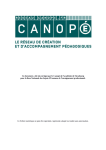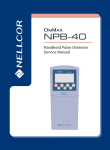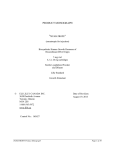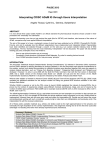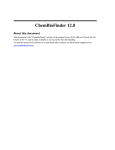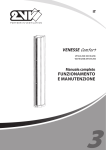Download Automated table generation: The SAS macro
Transcript
PhUSE 2008 Paper AD09 Automated table generation: The SAS macro %GEEWHIZ Guido Wendland, UCB Pharma, Monheim, Germany ABSTRACT The macro %GEEWHIZ creates tables in PDF-format in which observational units (“subjects”) and observations (“events”) are counted in categories. The subject count is usually related to the total number of subjects observed. The categories constitute columns of the table. In most cases the treatment group is the categorical variable but other categorizations are possible. The main purpose of the macro is to be able to produce a large amount of tables with just one macro in a controlled fashion. The macro combines content with layout and thus makes table production more efficient and fast. Macro parameters are defined in an xml-interface. The paper presents the architecture and provides examples. INTRODUCTION Table programming accounts for a high percentage of the statistical programmer trial activities. These activities consist of a couple of repetitive tasks that could be automated. There is usually a large variety of tables involved in clinical trials that require various programming approaches. Tables could however be categorized and for single categories a global macro could be useful. This global macro would automate a lot of steps and programming time would be vastly reduced. The macro %GEEWHIZ covers the very frequent category of tables in which subjects or events are counted across different groups (e.g. treatment groups). It was attempted to cover almost all tables for which this vague description applies. In the process of development the scope of the macro was expanded to meet the table requirements that occurred inside our studies. While the macro was initially developed to handle adverse events data, it is not restricted to this type of data. The objective of this macro is to combine ease of use with great flexibility. The paper describes the used techniques to solve this potential conflict of goals. Furthermore the macro %GEEWHIZ combines content with layout. The aspired flexibility of the macro can be summarized in couple of features: • Allows for a lot of user-specified options at the same time. • Creates tables for different domains (such as adverse events, vitals etc.) • Can be used for development and validation programming (including the option of an automatic compare) in case double programming is used. • Supports various content-related issues (like subgrouping for intensity, subsetting of drug-associated AEs, inclusion of total and active treatment total columns etc., by group processing, varying denominators etc.) • Allows for overlapping treatment categories (e.g. time of onset tables). It was attempted to reach ease of use by • An xml-interface that allows the user to specify the macro parameters. Thus it is easy to use previous examples and copy and paste information. • Generating helpful error or warning messages in case of inappropriate parameterization or use. • Supporting a standard table layout by using default parameter settings. User need not to care about layout issues (like column width, alignment, etc.). • A comprehensive user manual. THE MACRO ARCHITECTURE The macro parameters will usually be populated via an Excel-spreadsheet that should be stored as xml-file consisting of two sheets. The macro version of %GEEWHIZ to be used is also one parameter in the xml-file. All parameters of the xml-file are passed to the macro %GEEWHIZ via an interface macro %SETTABS. The main purpose of the macro %SETTABS is to allow for the use of different versions of %GEEWHIZ. The macro %SETTABS transforms the xmlfiles into SAS® datasets and calls the corresponding version of %GEEWHIZ. 1 PhUSE 2008 THE XML INTERFACE It was decided to use an external xml-interface to allow easier manipulations of a large number of parameters and tables, to provide a better overview of the tables to be produced and as a consequence to speed up the table production process. The xml-file can be opened for manipulation in Excel in the same way as an xls-file. This xml-file consists of two sheets, Sheet1 and Sheet2. The name of the xml-file is user-defined. Sheet1 controls the rows of the table and the general appearance. The column headers of Sheet1 (in row 1) represent the approximately 40 macro parameter names to be used with %GEEWHIZ. For most of these parameters the default specification can be used in many tables. Figure 1: Excerpt from sheet1 of the xml-Spreadsheet. All other rows usually correspond to one table via the macro parameter “KEYWORD” which links to the corresponding entry in another xml-file that defines the titles and footnotes of the tables. Sheet2 controls the columns of the intended table and also contains a first row of parameters. Because the number of (treatment) columns is a variable number sheet two is organized differently to Sheet1. In Sheet2 each row provides a column description of the table. Figure 2: Example of sheet 2 of the xml-Spreadsheet. 2 PhUSE 2008 Sheet1 and Sheet2 are linked via the macro parameter “COLUMNTYPE”. So you can use different column categorizations across the set of tables defined in the xml-file. There are a few requirements to bear in mind in order to read xml-files: Xml-files can automatically be opened with Excel and you can set this up as a default (right click on the file, Open with Microsoft excel and check “Always use this program to open these files”; alternatively specify specifying Tools-> Folder Options -> File Type etc). • To ensure proper conversion into a SAS file no empty field is allowed in the xml-file. If you want to have no information in an xml-field add a blank character (“ “) to it, e.g. by choosing Edit -> Replace and "replace all". • The macro %XLXP2SAS from SAS Institute (-> DelGobbo 2006) needs to be available. A typical invocation would look like this: % XLXP2SAS (excelfile=&PATH…./titles.xml); Under windows you have to close the xml-spreadsheet in order to retrieve the information from it. Users that prefer to enter the parameter values directly can alternatively use the macro %SETTABS (see below). THE MACRO %SETTABS The user has to invoke the macro %SETTABS to create the tables. This macro %SETTABS constitutes a link between the xml-file and the macro %GEEWHIZ, which is called automatically. This invocation of %SETTABS shows its minimal parameterization: The parameter TABLE refers to the xml-file that is used (in the same folder as the program) and the parameter KEY refers to the row in the xml-file and determines the table to be produced. It has to match the corresponding KEY that is specified inside the xml-file. Usually other macro parameters can be used as default. You can use %SETTABS also to overwrite macro parameter setting from the xmlfile by specifying OVERWRITE=%QUOTE(macro parameter1=value1, macro parameter2=value2,…, macro parameterN=valueN), e.g. if you quickly want to test the effect of a parameter setting without having to change the values in the xml-file. %SETTABS creates two temporary SAS datasets from Sheet1 and Sheet2 of the xml-file via the Macro %XLXP2SAS. Then it calls the corresponding macro version of %GEEWHIZ that is specified in the xml-file. One call of %SETTABS corresponds to one table. THE MACRO %GEEWHIZ The macro %GEEWHIZ is usually only called automatically via %SETTABS and the user does not have to care about it. To implement this, specify MACROTYPE=GEEWHIZ inside the xml-file. Inside the xml-File you can refer to different versions of the macro. The macro %GEEWHIZ combines the information of Sheet1 and the corresponding column information from Sheet2 (via the link variable COLUMNTYPE). It then creates the table using the macro parameter specifications from the xml-File. If the macro %GEEWHIZ is used as intended it creates a PDF-file for each table. The internals of the %GEEWHIZ macro are built around proc report and ods PDF. PREPARATION OF THE DATA Sometimes the datasets that are used as macro parameter inside the xml-interface need to be prepared. Usually two data files are needed to create a table with %GEEWHIZ: The first SAS dataset (e.g. ae) contains the subjects and corresponding events to be counted. In the following this will be referred to as event dataset. The second SAS dataset (e.g. disposit or demo) contains the number of subjects under risk categorized by group. In the following, this will be referred to as disposit dataset. Both datasets are merged during the process of table creation. Prior to calling %SETTABS these two (temporary) files sometimes have to be prepared by • Deriving variables in the event dataset to be used in where-conditions or as sorting variables • Slicing the event dataset into by-groups (e.g. Week at onset). • Create the disposit dataset from multiple sources in case of overlapping groups (e.g. the additional use of an exposure dataset for dose at onset analyses if a subject may be at risk in multiple groups). • Adding by-group variables to the event dataset (in case the by-group variable is a merge variable). • Duplicating the records of the disposit dataset in case of overlapping by-groups. • Using additional SAS-dataset to determine subjects at risk (e.g. in particular periods). • Derive variables that are used to specify a particular aspect of the layout (e.g. a variable that indicates where to include an empty line) • Derive numeric sort variables if you want to bring character values in a pre-defined order. In many cases you can –as a matter of choice - alternatively address data manipulation issues by preparing the files or by choosing the macro parameters appropriately. You can for example subset your event dataset prior to calling %SETTABS or you can do it by specifying a specific macro parameter. A general advice is hard to give, as the more efficient way of handling things depends on the context. A good practical example of which pre-processing steps can be necessary is shown in Example 6 below. 3 PhUSE 2008 A BRIEF DESCRIPTION OF MACRO PARAMETERS This paper can only provide a selection of the functionalities. The functions could be divided into: • Layout (such as column widths, empty lines, display of frequencies and percentages). • Content (data selection, subsetting etc.) • Text labels of columns and categories (e.g. text that appears in the header of the table). Table 1 and Table 2 provide a brief overview of the general functions of the macro parameters used inside %GEEWHIZ. In order to address many different aspects of the data and requirements of the customers additional options, features and functions can be specified for most of the macro parameters. These will usually be appended by commas and will internally be split up into multiple macro parameters. You can for example add an additional variable that is used for sorting to the first level variable (see parameter LEV1). Table 1: Brief description of most of the parameters in sheet1 and their basic functions Parameter Brief description 1 Keyword Variable that identifies the entry and matches with the entry from the file containing the titles 2 Skip Controls page breaks and allows you to enter blank lines 3 Macrotype This is the macro version that is used to process the data 4 Usubjid Usually the subject identifier. Could be a combination of variables if a subject falls into multiple treatment groups (e.g. dose at onset of adverse event) 5 Dset1 The SAS-dataset which contains the relevant information to be tabulated (“event” dataset). 6 D1_subset1 Contains a where condition for SAS-dataset DSET1 to subset the data 7 D1_subset2 Special subsetting of DSET1, e.g. to determine the numbers at risk or to exclude certain bygroups 8 Byvar Determines the variable (usually in DSET2) that is used for by-group processing 9 Lev1-Lev3 Up to three variables used to display the different levels (e.g. soc, hlt, and pt). Each new level is indented by two additional blank characters 10 Levterm This is the column header of the first column of the table. Use “|” as split character to wrap lines. 11 Lev1txt The text of this parameter is displayed on top of the table (non-indented) as summary for the 1st level variable. If text1 is omitted, no summary for the 1st level variable is used. 12 Col1min, This is the minimum (maximum) width in cm reserved for the first column of the table, which Col1max contains the first, second and sometimes a 3rd level variable. If no value is specified COL1MIN is automatically set to 20 cm 13 Subgroup This is the subgroup variable (optional) whose values are displayed in the second column of the table. The values of the subgroup variable are defined in → SUBVALS. 14 Subgrouplabel This is the text for the column header of the subgroup variable (e.g. relationship, intensity, maximum intensity) 15 Subvals The comma-separated list of values usually determines the values for the subgroup column. 16 Subvalorder Determines the order of priority for SUBVALS in the presence of a value for SUBGROUP. 17 Dset2 The SAS-dataset which contains the treatment group information and information concerning the populations (e.g. disposition dataset). 18 D2_subset Contains a where condition for SAS-dataset DSET2 to subset the disposition dataset. 19 Header_display_n This determines whether of not the N’s should be displayed in the header block of the table 20 Selectrows This parameter allows you to exclude rows from the table display without deleting data from the dataset that is to be displayed. 21 Overall If this parameter is not blank, it determines the text for the Overall column(s) on the right side of the table. If the parameter is blank, no overall column is created. 22 Orderbytotal Determines the rank of the overall column in specifying the sort order of the 2nd and 3rd level variable in the first column. 23 Columntype Determines the appearance of the treatment columns and refers the same variable in sheet2 of the xml-file. 24 Displaytype Determines how frequencies and percentages and events are displayed 25 Percentformat Determines the number of digits used in the percentage display. 26 Minimumwidth Allow you to switch between a standard column width and a minimum column width to display the treatment groups. 27 Spanningtext This optional text is placed on top of the treatment columns as spanning text st nd 28 Showbody Determines whether the frequencies and percentages are summarized for the 1 and 2 level. 29 Cretable Indicates whether or not the PDF-file should be produced (for validaton programmers a PDF is not required) 30 Newtarget Allows you to start e.g. an automated compare. 4 PhUSE 2008 Table 2: Description of the parameters in Sheet2 Parameter Brief description Columntype Integer Number for the table that matches with the corresponding value of sheet1 Var This is the name of variable that is used for grouping the data into the columns. This is usually a numeric treatment group variable. Character variable are also allowed if each distinct value is displayed as column. It is also possible to specify a dose variable if each column should represent a single or combined dose class. Start Determines the start value for the category. The categories must be mutually exclusive. End Determines the end value for the category. To include only a single value into a groups END should be the same value as START. The categories must be mutually exclusive. The overall column(s) are created inside sheet1. Sortrank Determines the rank of the column in specifying the sort order of the 2nd level variable (first column). The provided numbers must be unique but do not need to be successive. If a group should be excluded from the active treatment group total add: “,x” or any other character. Label Provides the label for the column that appears in the header of the table. AUTOMATED COMPARE One advantage of the xml-user interface is that a large number of tables can be handled efficiently. That is way the macro is often used to create a large number of tables with just one program. The macro %GEEWHIZ can be used for development and validation of tables. For validation programmers (in case of double programming) it offers the possibility to perform an automated comparison to the developed file provided that some requirements are met (e.g. the variable names of the compared variables need to be equal). The requirements are met if both the development and the validation of a table were done with the macro. With the automated compare (→ parameter NEWTARGET in sheet 1) the comparison procedure is invoked for a table and the *.lst outputs created by the compare procedure are concatenated. If the number of tables is large this yields a big file that can be tedious to check for findings. An additional SAS macro was designed to extract the relevant information form the *.lst file and summarize the results in an xml-file. It is optionally called as the last step of the validation program, i.e. after the *.lst was already created. EXAMPLES The adverse event data presented in the following examples is completely fictional and only serves the purpose to show particular test cases and to illustrate how the macro % GEEWHIZ handles these specific test cases. The macro is particularly suited to process adverse events data. The last example shows its application to real-life laboratory data. This chapter can only cover a couple of different fields of application. If shows which changes would be necessary if you are starting from a base case. Each example will be started with an overview of the changes in the parameter setting and followed by the table that would be generated with the parameter setting. In the tables a couple of comments are inserted to further explain the effect of a certain parameter specification. EXAMPLE 1 The following macro parameters would be specified for a “standard” table. In the following parameter overview the columns of sheets1 are expressed as rows: 5 PhUSE 2008 Table 3: Parameter settings in sheet 1 for a standard table Column Example 1 Incidence of all Treatment-Emergent Adverse Events (TEAEs) 1 Keyword example 1 3 macrotype geewhiz_v1_5 4 usubjid usubjid 5 Dset1 ae 6 D1_subset1 ss_g="Yes" 9 lev1 socdm 9 lev2 hltdm 9 lev3 ptdm 10 levterm MedDRA (V9.1)| System Organ Class/| High Level Term/| Preferred Term 12 col1min 4 12 col1max 15 17 Dset2 disposit 18 D2_subset ss_g="Yes" 23 Columntype 1 24 Displaytype 1 25 Percentformat percnew 26 Minimumwidth yes 28 showbody yes 29 cretable yes This parameter setting yields the following result: Figure 3: A “Standard” table 6 PhUSE 2008 EXAMPLE 2 Now the adverse events are to be categorized by maximum intensity via an additional subgroup variable. Table 4 highlights the changes as compared to the base case Table 4: Inclusion of a subgroup variable to categorize intensity Incidence of all TE Card. + Nerv. syst. disorders - (SKIP=,,1), SUBGROUP, Table 6_1 SUBGROUPLABEL, SUBVALS 1 Keyword Example6_1 2 Skip ,,1 5 Dset1 ae1 6 D1_subset1 ss_g=”yes” and substr(socdm,1,1) in (“C”,”N”) 11 Lev1txt Any System Organ Class 13 Subgroup Intensity 14 Subgrouplabel Maximum Intensity 15 Subvals Mild, Moderate, Severe, Total 16 Subvalorder 3,2,1,4 21 Overall ,Rotigotine Total,1 28 Showbody no Figure 4: A table with a subgroup column 3 3 1 2 1 4 4 2 5 5 The parameter SHOWBODY=no suppresses the display of frequencies and percentages for the first level entries. It also suppresses the display of the summary of the first level entries (e.g. System Organ Class) specified by LEV1TXT=Any system organ class (see also the next example where this summary line is displayed). This example shows that sometimes parameters interact with each other. The parameters SUBGROUP, SUBGROUPLABEL, SUBVALS, and SUBVALORDER are often used in combination. Specifying a value for SUBVALORDER implies that the categories follow a priority: If a subject experiences an adverse event twice the lower category would not be counted. The parameter OVERALL is starting with a comma, which means that no overall total is calculated but an active treatment total. The adjacent “1” indicates that the last group is to be excluded from the active treatment total. 7 PhUSE 2008 EXAMPLE 3 This example shows another case where parameters interact with each other. Here the parameter SUBVALS could also be used without SUBGROUP: Table 5: Use of parameter SUBVALS without parameter SUBGROUP 1 5 9 9 9 11 13 15 21 Incidence of all TEAEs - Only LEV2, SUBVALS: existing values + blank line Example7_1 ae1 Table 7_1 Keyword Dset1 Lev1 Lev2 Lev3 Lev1txt Subgroup Subvals Overall Socdm Any System Organ Class Cardiac disorders,Nervous system disorders,,Vascular disorders,Psychatric disorders ,Rotigotine Total,1 Figure 5: Using the SUBVALS parameter to manipulate the first column 1 1 2 2 3 3 8 PhUSE 2008 EXAMPLE 4 Sometimes treatment groups are not mutually exclusive, e.g. if you want to display adverse events by dose at onset (variable exdostot), a subject might experience the same adverse at different doses if the subject is titrated to a maintenance dose. Table 6: Specifications if treatment columns are not mutually exclusive Table 8_1 1 4 5 6 17 21 23 Keyword Usubjid Dset1 D1_subset1 Dset2 Overall Columntype Incidence of all TE Card. + Nerv. syst. disorders by dose at Onset USUBJID, DSET2, and COLUMTYPE Example8_1 Usubjid exdostot ae1 ss_g=”yes” and substr(socdm,1,1) in (“C”,”N”) dispoall ,Rotigotine Total,1 3 As the dose at onset is used here sheet 1 refers to a different value of COLUMNTYPE in sheet 2 (see specification in the figure below). Figure 6: Using a combination of two variables to merge the “event” dataset with the “disposition” dataset. 1 1 9 PhUSE 2008 EXAMPLE 5 If you want to group column together (e.g. if you have multiple doses of the same active treatment) it makes sense to use a spanning header to indicate that certain columns belong together. Furthermore, it is shown how to include treatment columns into the table that usually would disappear because no subject is in that treatment group. In the following example this occurs because it is restricted to subjects that reach a certain period in the study. Table 7: Implementation of a spanning header and inclusion of columns with N=0 Table 11_1 1 5 6 18 21 23 25 27 Keyword Dset1 D1_subset1 D2_subset Overall Columntype Percentformat Spanningtext Incidence of all TE Card. + Nerv. syst. disorders - D2_SUBSET (N=0), OVERALL, COLUMNTYPE=1 n, SPANNINGTEXT=Rot. Example11_1 ae1 ss_g=”yes” and substr(socdm,1,1) in (“C”,”N”) ss_g='Yes' and maint1="Yes" Overall Total ,Rotigotine Total, 1 1,x Perc Rotigotine Here the parameter OVERALL interacts automatically with the parameter SPANNINGTEXT. The text indicates that the overall total and the active treatment total (i.e. Rotigotine total) are to be displayed. Furthermore a “1” is added to indicate that one additional column apart from Placebo is excluded from the active treatment total. This is recognized by the parameter SPANNINGTEXT which begins at the 2nd treatment column (default) and ends with the column “Rotigotine Total”. Percentages are displayed here without any decimals to save space (PERCENTFORMAT=perc). The setting COLUMNTYPE=1,x ensures that all (intended) treatment groups are displayed even if no subjects fall into a group. Figure 7: Using a spanning header and including treatment columns with no subjects (N=0). 1 3 4 2 3 1 4 10 2 PhUSE 2008 EXAMPLE 6 The last example handles a more complex real-life situation and shows that %GEEWHIZ is not only restricted to adverse events data. This is a more sophisticated use of the macro. The used data needs to be pre-processed here (usually in the SAS program that contains the %SETTABS invocations) in order to generate the variable “critn” to sort LEV2, to create a variable “nr” that defines empty lines between the abnormalities and the marked abnormalities, and to generate a dataset “hema511” that only contains the hematology parameters of the study 511. The latter is required because the full input data (disregarding the subsetting condition D1_SUBSET1) is used to determine the subject counts (see comment 4 below). Table 8: Implementation of special laboratory table 1 2 5 6 9 9 10 17 18 21 24 Hematology – Abnormalities/Marked Abnormalities iss_ap_lab_hem_rd_511 ,nr,2 Hema511 yes Markfnd=”Yes” lbtest Markcrt, critn Parameter (unit)| Criteria Table 112_2 Keyword Skip Dset1 D1_subset1 Lev1 Lev2 Levterm Dset2 D2_subset Overall Displaytype Subject ss='Yes' and prindic = 'Advanced PD' and studyid='511' ,Rotigotine Total 3N1ly,0.4,Count Figure 8: Displaying abnormalities/ marked abnormalities with special features 1 4 3 3 2 1 2 4 5 5 11 PhUSE 2008 INTERACTIONS WITH OTHER MACROS The invocations of additional macros are embedded into the macro %GEEWHIZ. This includes two error check macros, that check the macro parameters and the used datasets and variables for validity and a few other macros, e.g. a macro that takes care that indented text wraps appropriately. All of these macros are part of a macro library whose members are automatically compiled. CONCLUSION The macro %GEEWHIZ tries to combine user friendliness with a great deal of functionality and flexibility. Users report that it requires a bit of a learning curve to get used to it. However, once you have some experience it pays off rather quickly because you can generate a large number of tables in a more or less automated fashion. Its basic use is pretty straightforward and with some experience you can implement more sophisticated solutions. The experience has shown that the %GEEWHIZ macro can handle approximately 90% of the adverse events tables, concomitant medication and concomitant diseases tables. Furthermore, it was also used to create tables from a lot of other domains such as laboratory tables or vital sign tables. The macro has evolved over time with a lot of features and solutions being implemented into an already existing macro. The new functions were built-in as options by appending values to existing macro parameters over the years and over the projects. New macro parameters were not introduced into the xml-spreadsheet. On the one hand this procedure allows the use of the same set of macro parameters for simple tables and more complex tables. On the other hand the correct parameter specification often requires a look into the user manual because it can be complex. As a drawback due to the seemingly complexity of the macro, some users are hesitant to start using the macro and it needs some promotion to persuade these users. REFERENCES DelGobbo, V. 2006. "Creating AND Importing Multi-Sheet Excel Workbooks the Easy Way with SAS® ". Proceedings of the Thirty-First Annual SAS Users Group International Conference, 31. CD-ROM. Paper 115. Available http://www2.sas.com/proceedings/sugi31/115-31.pdf. CONTACT INFORMATION Your comments and questions are valued and encouraged. Contact the author at: Guido WENDLAND UCB Pharma SA Alfred-Nobel Str 10 40789 Monheim Germany Work Phone: + 49-2173-48 1944 Fax: + 49-2173-48 1947 Email: [email protected] Web: www.ucb-group.com Brand and product names are trademarks of their respective companies. 12












